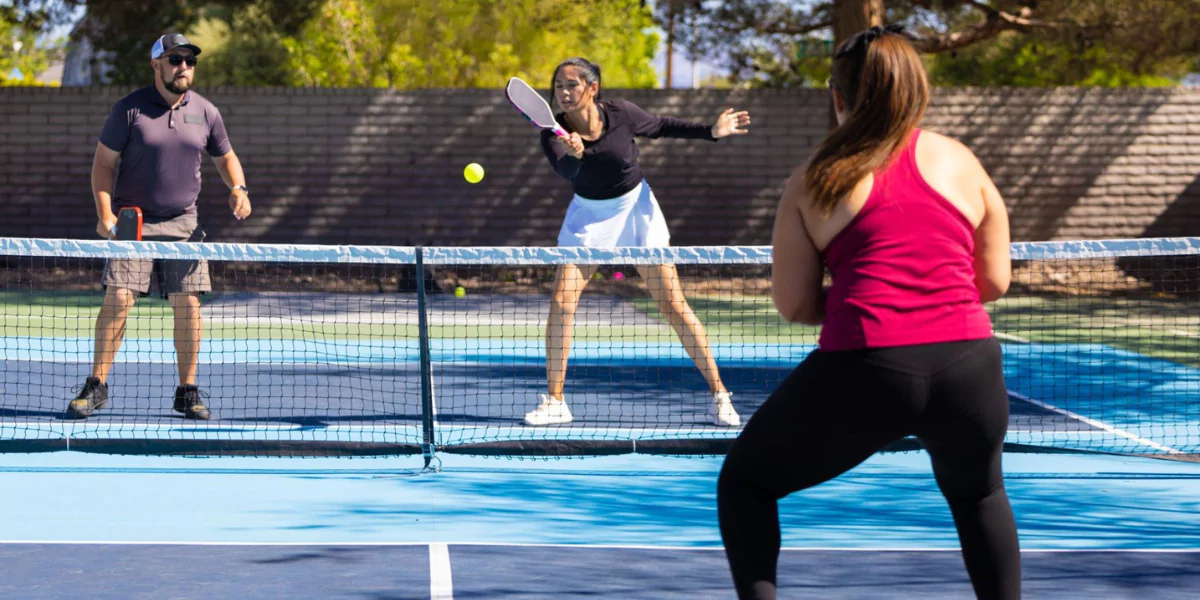Pickleball is a sport that can be enjoyed both inside and outside. But did you know that there are different kinds of pickleballs for different settings? In this article, we will compare indoor and outdoor pickleballs in five aspects, and how to recognize them.
How to Distinguish Indoor and Outdoor Pickleballs
The best way to distinguish indoor and outdoor pickleballs is by looking at their hole number, hole size, weight, hardness, and durability. These features affect how the balls behave in different climates, court types, and wind levels. Let’s examine each of these factors in detail.
Hole Number
One of the most obvious differences between indoor and outdoor pickleballs is the hole number they have. Indoor pickleballs usually have 26 holes, while outdoor pickleballs have 40 holes. The reason for this difference is that outdoor pickleballs need more holes to lower wind drag and increase aerodynamics. Indoor pickleballs, on the other hand, have fewer holes to make them fly faster and smoother in a stable environment.
According to the official standards of the USA Pickleball Association (USAPA), the authority of the sport, a pickleball ball must have between 26 and 40 holes. However, some makers may produce balls with slightly more or less holes, as long as they meet the other requirements.
Hole Size
Another difference between indoor and outdoor pickleballs is the size of their holes. Indoor pickleballs have bigger holes than outdoor pickleballs, which makes them softer and quieter. Outdoor pickleballs have smaller holes than indoor pickleballs, which makes them harder and louder.
The USAPA requires that the hole size of a pickleball ball must be between 0.08 inches (2 mm) and 0.13 inches (3.25 mm). The hole size must also be consistent throughout the ball.
Weight
The weight of a pickleball ball also varies depending on whether it is made for indoor or outdoor use. Indoor pickleballs are lighter than outdoor pickleballs, which makes them easier to control and maneuver. Outdoor pickleballs are heavier than indoor pickleballs, which makes them more stable and resistant to wind.
The USAPA specifies that the weight of a pickleball ball must be between 0.78 ounces (22 grams) and 0.935 ounces (26.5 grams). The weight must also be consistent throughout the ball.
Hardness
The hardness of a pickleball ball affects how it bounces and reacts to the paddle. Indoor pickleballs are softer than outdoor pickleballs, which makes them more forgiving and less likely to crack or break. Outdoor pickleballs are harder than indoor pickleballs, which makes them more responsive and durable.
The USAPA measures the hardness of a pickleball ball using a device called a Shore D Durometer, which applies a standardized force to the ball and records its indentation. The USAPA requires that the hardness of a pickleball ball must be between 40 and 50 on the Shore D scale. The hardness must also be uniform throughout the ball.
Durability
The durability of a pickleball ball depends on how well it can withstand repeated impacts, abrasions, and exposure to different elements. Indoor pickleballs are less durable than outdoor pickleballs, because they are made of softer materials that can wear out faster on rough surfaces. Outdoor pickleballs are more durable than indoor pickleballs, because they are made of harder materials that can last longer on smooth surfaces.
The USAPA does not have a specific requirement for the durability of a pickleball ball, but it does test each approved ball for its performance and quality. The USAPA also recommends that players replace their balls regularly to ensure optimal playability.
Can You Use Indoor Pickleballs Outside and Vice Versa?
While it is possible to use indoor pickleballs outside and vice versa, it is not advisable to do so. Using the wrong kind of ball for your setting can affect your game negatively, as well as damage your equipment.
For example, if you use an indoor ball outside, you may experience:
- Reduced accuracy and consistency due to wind interference
- Increased noise and vibration due to hard impact
- Decreased lifespan due to cracking or splitting
On the other hand, if you use an outdoor ball inside, you may experience:
- Reduced speed and control due to air resistance
- Increased bounce and rebound due to hard surface
- Decreased comfort due to hard feel
Therefore, it is best to use the suitable kind of ball for your setting, as it will enhance your performance and enjoyment of the game.
Also Read: what kind of ball is used in pickleball
The Right Pickleball Matters
As you can see, there are significant differences between indoor and outdoor pickleballs, and they are not interchangeable. Choosing the right kind of ball for your setting is important, as it will affect your game in various ways.
To help you choose the right pickleball, here are some tips to consider:
- Check the label and packaging of the ball to see if it is made for indoor or outdoor use
- Look at the number and size of the holes on the ball to determine its aerodynamics and hardness
- Weigh the ball to determine its stability and resistance
- Feel the ball to determine its softness and durability
- Test the ball on your court to see how it bounces and reacts to your paddle
By following these tips, you will be able to find the best pickleball for your setting, and enjoy the game to the fullest.
Also Read: Best pickleball Balls
People also ask
Can outdoor pickleballs be used indoors?
Outdoor pickleballs can be used indoors, but they are not recommended. Outdoor pickleballs are heavier, harder, and louder than indoor pickleballs, which can make them less suitable for indoor play. Outdoor pickleballs may also bounce too high or fast on indoor courts, which can affect your game negatively.
How can you tell the difference between indoor and outdoor pickle balls?
The best way to tell the difference between indoor and outdoor pickle balls is by looking at their hole number, hole size, weight, hardness, and durability. Indoor pickle balls usually have 26 holes, bigger holes, lighter weight, softer hardness, and less durability than outdoor pickle balls. Outdoor pickle balls usually have 40 holes, smaller holes, heavier weight, harder hardness, and more durability than indoor pickle balls.
What is the difference between the green and yellow pickleballs?
The difference between the green and yellow pickleballs is mainly their color. Green and yellow are two of the most common colors for pickleballs, but they do not indicate any difference in their performance or quality. However, some players may prefer one color over another based on their personal preference or visibility.
How many holes do outdoor pickleball balls have?
Outdoor pickleball balls have 40 holes, according to the official standards of the USA Pickleball Association (USAPA). The reason for this number is that outdoor pickleball balls need more holes to lower wind drag and increase aerodynamics. However, some makers may produce balls with slightly more or less holes, as long as they meet the other requirements.



